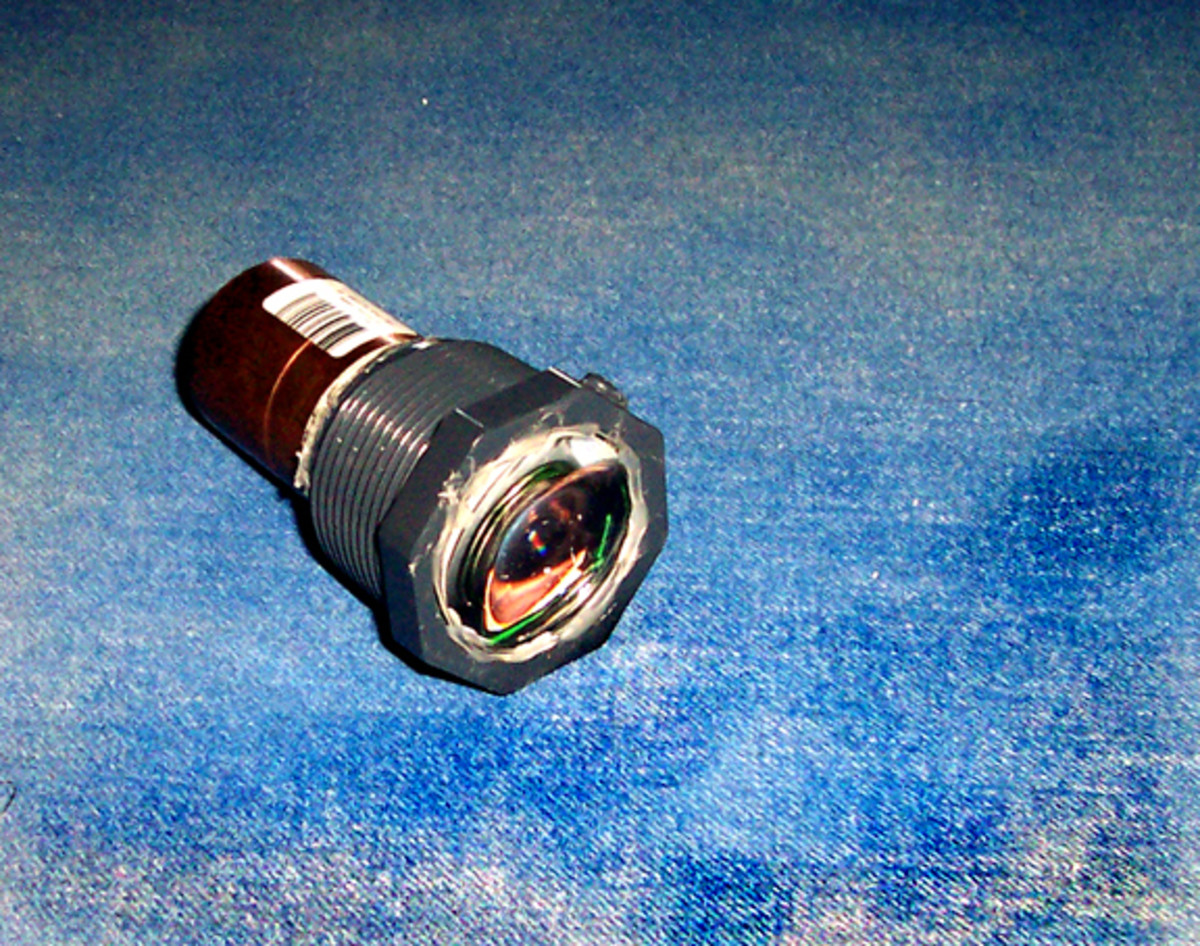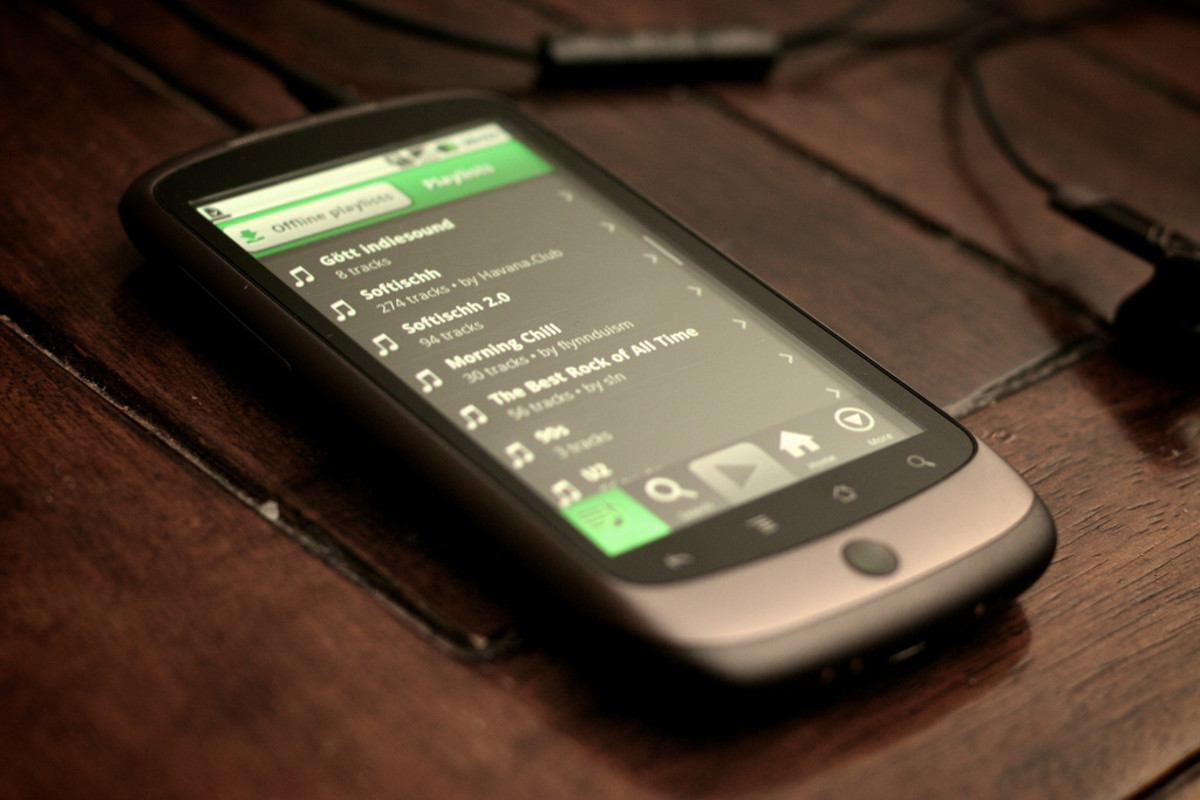- HubPages»
- Technology»
- Computers & Software»
- Computer Buying Guides
Review: Homido VR Headset
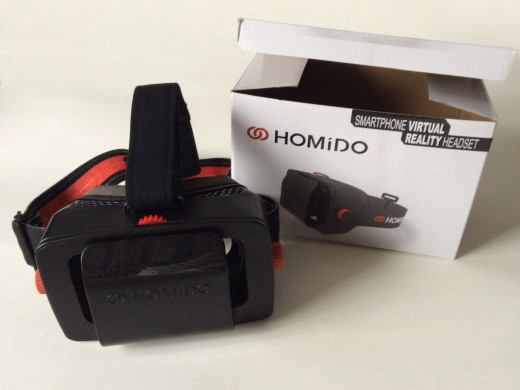
It's Time for Virtual Reality!
So you're ready to experience the virtual reality revolution, are you? Are you eager to find out what it's all about?
We've been waiting for virtual reality for a long time. The concept sprung into public awareness in the late 80s or early 90s, and was capitalized on by such television shows as Star Trek: The Next Generation and movies such as Lawnmower Man. But it's been a long time to hit the mainstream, so you might as well take advantage of it now.
Virtual reality has only recently reached the point where it's affordable and practical for the masses. After all, your smartphone already has built into it most of the elements that you need for some pretty convincing virtual reality: a super high-resolution wide screen, light weight, an accelerometer, a gyroscope, and most importantly of all, an incredibly powerful processor that puts it in the class of supercomputers of just a couple of decades ago.
It also has an affordable price; after all, you probably own a smartphone already. (If you don't, Apple's iPod touch can also run virtual-reality).
Make no mistake: the modern smartphone has the power of systems costing tens or even hundreds of thousands of dollars were it to be purchased in the 1990s. In fact, the VR capabilities of such devices not so long ago could not have been purchased at any price. So you might as well take advantage of the mind blowing virtual-reality possibilities that now await you!
The beauty of it all is, it doesn't have to cost a lot of money to turn your smartphone into an awesome virtual-reality device. In fact, you can construct such a device out of cardboard. All you need are a pair of suitable lenses to focus the smartphone image into your eyes.
But perhaps you want something a little nicer than cardboard for entering the world of virtual-reality, something with a little pride of ownership. In this case, you may wish to choose a prebuilt, third-party headset.
Be aware, however, that there are a number of competing headsets, each with their own strengths and weaknesses. On this hub, I will be exploring the Homido, an iPhone-compatible virtual-reality headset, so you can determine how well it will meet your needs.

What is Homido?
Homido is a French company that ships its products to the United States and elsewhere; my headset took about a week for delivery. There is a tracking feature on its website so you can track the status of your delivery, but it is in French, so prepare to do a little translating. The rest of the site has both an English and French version.
There are a number of competing third-party headsets on the market, in addition to Google cardboard (which can also work with both Android and the iPhone). I chose Homido because it can work with different sizes, makes and models of oPhone. Another advantage, as an eyeglass wearer, is that it can be easily adjusted to suit different types of vision.
Purchasing the headset from the Homido website will require some conversion by American users, since prices are listed in euros rather than American dollars. As of this writing, the headset lists on the site for 79.99 €, which comes to approximately $102.00.
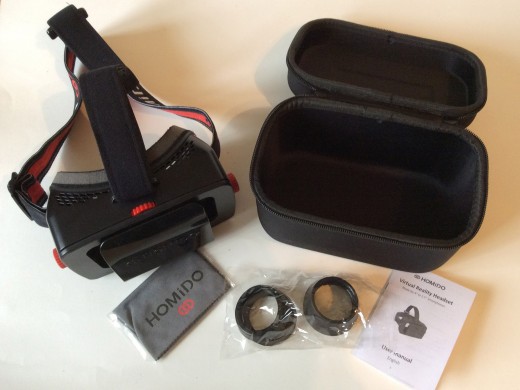
What You Get
The Homido headset comes with a rigid foam cloth covered case, a brief instruction manual in English and French, lens cleaning cloth, one elastic strap that goes around the head and another that goes over the top of the head for additional security and, of course, the headset itself.
I found the side strap of the headset to be of good quality. This strap is adjustable elastic with silicone strips on the inside to reduce slipping. The over-the-head strap is Velcro along the entire underside for adjusting to any position. The main strap is already attached to the headset when you open the package. You attach the overhead strap by threading it through a loop on the top of the headset and at the back of the main strap.
The Homido is adjustable to different users and vision levels, one of the features that eased my mind when ordering. For one thing, there is an eye-to-lens distance setting. This is controlled by two red knobs on either side of the headset which bring the lenses closer to or further from your eyes. In addition, there are three different pairs of silicone cups in different sizes that hold the lenses for further adjustability to users’ individual vision levels.
Pros and Cons of the Homido Headset
Pros
| Cons
|
|---|---|
Comfortable straps hold headset securely
| Foam cushioning too soft
|
Good quality lenses
| Nose opening might restrict breathing
|
Adjustable interpupillary distance (IPO)
| Insertion of phone could scratch glass
|
Adjustable eye-to-lens distance setting
| |
Holds a wide variety of phone makes and models
|
My Homido VR headset rating
Buy a headset from Amazon
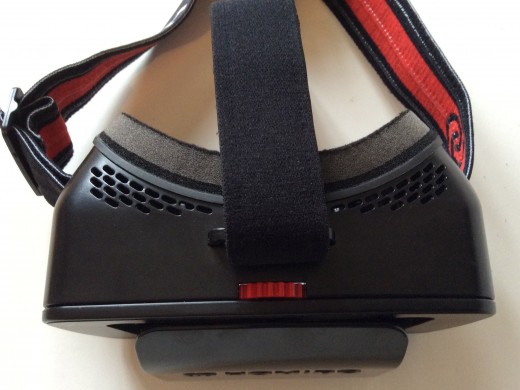
Adjusting the Headset
Ironically, even though I am nearsighted, I found the default (middle size) set of lens holders and the default eye to lens distance setting to work best for me. I think that the lenses themselves help to provide a certain amount of vision correction. And, of course, the phone is not very far from your eyes, anyway. You do need to remove your glasses before using the headset.
You will want to experiment a bit after receiving your headset. The lens holders that come with a headset are made of soft silicone and are easy to remove. Simply grasp them firmly from inside the headset and pull them out. The lenses go into the holders with the curved part of the lens pointing away from your eyes.
The smaller or larger lens holder is snapped into place using a very light pressure. I fumbled for several minutes the first time I tried it because I thought it required more pressure than it actually does; a very light pressure is all that is needed. You should feel a very slight snapping sensation when the holder is properly seated. Before snapping the lens holder into place, however, be sure to wipe off any fingerprints with the included lens cloth.
To adjust the eye-to-lens distance, simply put the headset on and turn both side knobs simultaneously. The interpupillary distance setting can also be adjusted. This is done by turning the top knob either right or left. I found the most distant setting works best for me.
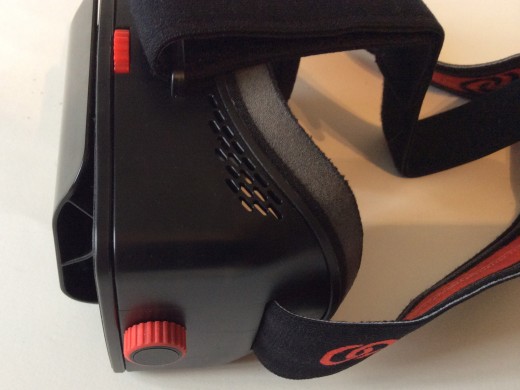
How Comfortable is the Homido?
As far as the comfort level of the headset, it could be better and it could be worse. The straps do a fairly good job of holding the headset in place (that the headset is not very heavy helps). However, I found the foam cushioning around the area where the headset touches your face to be a little too soft. The foam wants to push to one side when the headset is in place, causing the hard plastic to come in contact with your skin.
The foam cushion appears to be interchangeable, but I don't know of any other options that are available for it, aside from, perhaps, replacing the foam with an identical piece when the original becomes dirty or worn (the headset comes with only one cushion).
A nice feature are venting holes at the top of the headset which allow perspiration to escape and keep it from fogging up the lenses. However, I found the nosepiece opening to be a little too narrow and to press against the sides of my nose, inhibiting breathing, and I do not have particularly wide nostrils. If you find yourself breathing through your mouth when using this headset, that's probably the reason why. Homido should have made the nosepiece opening wider.
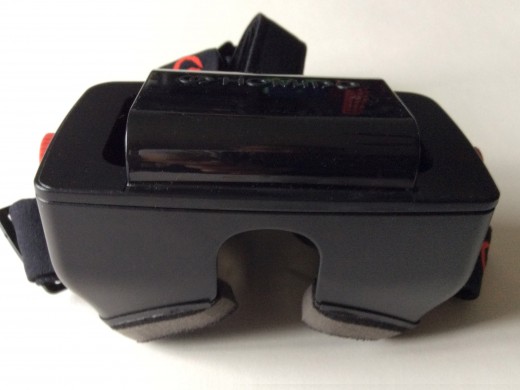
Lens Quality
The lenses are custom-made, according to Homido’s website, and appear to be of good quality. They provide a fairly sharp image and a remarkably good field of view. Of course, the field of view is not as good as you experience in real-life, but this is understandable since you're simply looking at a smartphone screen. The field of view is much better than, say, looking through a pair of binoculars. Homido claims a 100° field of view.
I did detect a few stray shafts of light around the periphery of my vision when using the headset, but nothing terribly objectionable. I have not had a chance to compare the field of view with a higher-end VR headset such as the Oculus Rift.
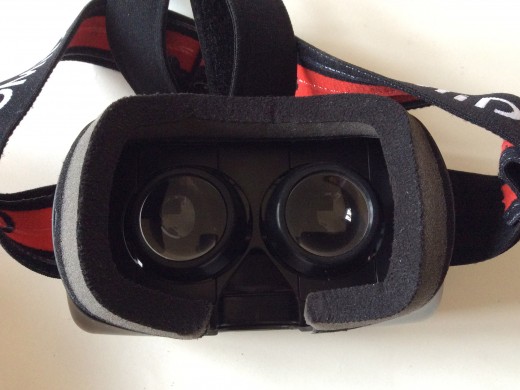
Securing the Phone
One of the unique things about the Homido headset is the way it holds your smartphone in place. This is done through a clip at the front of the headset (basically just a molded piece of plastic).
This has both advantages and disadvantages. The advantage is that the Homido can accept a wide variety of makes, models and sizes of smartphone, everything from one of the smaller sizes to a full-blown “phablet” like the iPhone 6 Plus.
The downside is that, since the phone slides under the clip and the clip exerts some pressure while this is being done, there's a good possibility of it eventually scratching your smartphone’s screen, and indeed, this is what has happened to me. It is very easy for a bit of dirt, sand or other grit to come in contact with the phone's glass, and, since the clip exerts pressure onto the back of the phone as you slide it in, this could result in scratched glass.
To prevent this from happening again in the future, I have glued some black velvet to the top edge of the front of the headset to provide a protective cushioning surface for the phone. In addition, I pull the clip open slightly when I insert or remove the phone.
I find this an unfortunate downside to the Homido headset. It is not a happy feeling to have your $600 smartphone scratched by a $100 VR headset. If you purchase this headset, I strongly recommend that you use a screen protector on your phone.
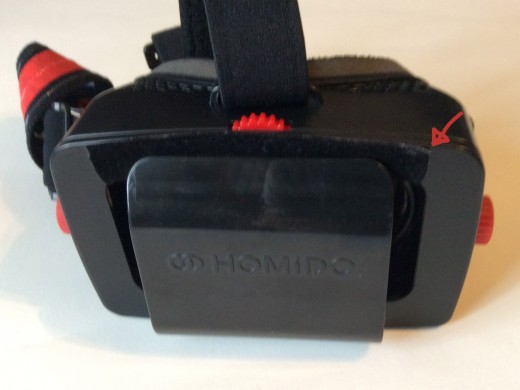
Poll
What brand of VR headset have YOU tried?
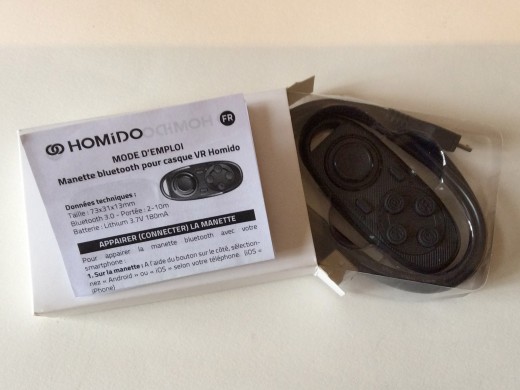
Homido Bluetooth Gamepad
Homido also sells a Bluetooth gamepad at a separate charge of 14.95 € (about $19.00 US). This can be useful for controlling certain virtual-reality games.
The controller is quite small (hardly larger than a large keyfob). It has a joystick button on the left and control buttons on the right (on Android devices, the control buttons can be used for controlling your player's music). There are no batteries to fumble with or that need to be replaced. The controller comes with a USB cable for charging.
To be honest, most virtual-reality games (at least for IOS) do not use or need a controller. Most IOS games are controlled by looking in a particular direction, and one I tried uses a magnet, like on Google Cardboard.
I have found only one iPhone game so far, a flight simulator, that uses a controller. When I tried the Homido Bluetooth gamepad with this game, it worked fine.
Obviously, you can buy a controller of any brand at any time, since it works wirelessly with your phone and has no connection to the headset itself. Aside from a slightly slippery joystick button, the Homido controller seems to work well.
YouTube Review
Homido website (English)
to learn more or to order the Homido headset:



